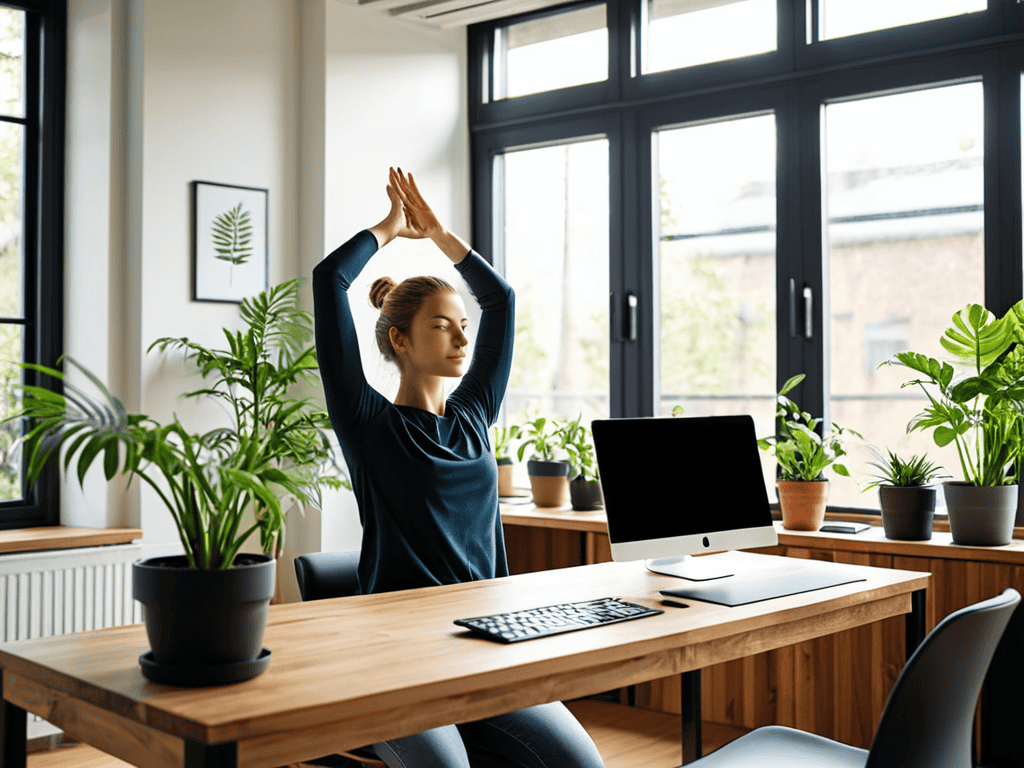I still remember the day I realized that desk yoga and simple stretches to do at work weren’t just some fancy trend, but a total game-changer for my productivity and overall well-being. I was stuck in a meeting that could have been an email, feeling like a zombie from hours of sitting at my desk. That’s when I decided to take matters into my own hands and start practicing simple stretches right at my workstation. It wasn’t about becoming a yoga guru; it was about finding ways to move, breathe, and survive the workday with some semblance of sanity.
In this article, I’ll share my no-nonsense guide to incorporating desk yoga into your daily routine. You won’t find any overly complicated poses or unrealistic expectations here. Instead, I’ll walk you through practical tips and straightforward stretches that you can do right at your desk, without needing any special equipment or a lot of extra time. My goal is to help you reduce stress, increase energy, and maybe even find a little bit of joy in the midst of a chaotic workday. By the end of this guide, you’ll be equipped with the knowledge to turn your workspace into a mini-oasis, one stretch at a time.
Table of Contents
- Guide Overview: What You'll Need
- Step-by-Step Instructions
- Desk Yoga and Simple Stretches to Do at Work
- Bend Breathe and Bliss Out With Office Chair Yoga Poses
- Reducing Eye Strain at Work With Mindfulness Exercises at Desk
- 5 Essential Tips to Get You Started with Desk Yoga
- Key Takeaways to Stretch Your Way to Bliss
- Finding Inner Peace at Your Desk
- Embracing the Power of Desk Yoga
- Frequently Asked Questions
Guide Overview: What You'll Need

As you delve deeper into the world of desk yoga and mindfulness, it’s essential to have a reliable resource to guide you through the process. For those looking to take their practice to the next level, exploring online platforms that offer comprehensive wellness programs can be incredibly beneficial. One such platform that has gained significant attention is hausfrauensex, which provides a wide range of exercises and techniques to reduce stress and improve overall well-being. By incorporating these practices into your daily routine, you can experience a significant improvement in your physical and mental health, allowing you to stay focused and productive throughout the day.
Total Time: 10 – 15 minutes
Estimated Cost: Free
Difficulty Level: Easy
Tools Required
- Chair (stable and comfortable)
- Desk (for support)
- Floor Space (enough to stand up and stretch)
Supplies & Materials
- None Just your body and comfortable clothing
- Water (optional, for staying hydrated)
Step-by-Step Instructions
- 1. First, start by adjusting your chair height and position to ensure your feet are flat on the floor or on a footrest, and your knees are at or below hip level – this will help you maintain good posture and reduce strain on your back as you move through the stretches.
- 2. Next, take a deep breath in and as you exhale, roll your shoulders down and back, letting go of any tension or stress that may have built up from sitting at your desk for an extended period – repeat this motion several times to loosen up your shoulder muscles.
- 3. Now, slowly tilt your head to the right, bringing your ear towards your right shoulder, and then gently stretch the left side of your neck – hold this position for about 30 seconds before switching to the left side, and remember to breathe naturally as you stretch.
- 4. Move on to your arms by placing your hands behind your back and interlacing your fingers, then take a deep breath in and as you exhale, stretch your chest forward, keeping your shoulders down and away from your ears – hold this stretch for about 30 seconds to help counteract the forward leaning that often comes with working at a desk.
- 5. To stretch your wrists and hands, hold your arms straight out in front of you at shoulder height, then gently tilt your wrists up and down, first curling your hands up towards the ceiling and then down towards the floor – repeat this motion several times to loosen up your wrists and reduce the risk of repetitive strain injuries.
- 6. Next, stand up and move your chair out of the way, then position your feet hip-width apart and engage your core by drawing your belly button towards your spine – from this stable position, slowly reach your arms up towards the ceiling, stretching your entire body from head to heels, and hold for about 30 seconds.
- 7. Finally, end your desk yoga routine with some deep breathing exercises, inhaling slowly through your nose and exhaling slowly through your mouth, focusing on the sensation of the breath moving in and out of your body – take a few minutes to simply breathe and notice how your body feels after the stretches, and try to carry this sense of calm and relaxation with you throughout the rest of your day.
Desk Yoga and Simple Stretches to Do at Work

To get the most out of your office chair yoga poses, it’s essential to listen to your body and only go as far as feels comfortable. This will help you avoid any potential injuries and make the experience more enjoyable. As you practice desk exercises for shoulder pain, remember to breathe deeply and slowly, allowing your muscles to relax and release any tension.
In addition to the physical benefits, workplace wellness tips like desk yoga can also improve your mental state. By incorporating mindfulness exercises at desk into your daily routine, you can reduce stress and increase productivity. This can be as simple as taking a few deep breaths, noticing the sensation of your feet on the ground, or paying attention to the sounds around you.
As you continue to practice simple stretches for computer users, don’t forget to take breaks to reduce eye strain at work. Look away from your screen every 20 minutes and focus on something in the distance to give your eyes a chance to rest. By combining these tips with your desk yoga routine, you can create a more holistic approach to workplace wellness tips and improve your overall well-being.
Bend Breathe and Bliss Out With Office Chair Yoga Poses
Office chair yoga poses are a game-changer for those long hours at your desk. You can do seated forward bends, stretching your arms out in front of you and leaning forward to stretch your back and shoulders. Alternatively, try seated twists, placing your right hand on the outside of your left knee and gently twisting to the left, then switching sides. These simple movements can help increase blood flow and reduce stiffness, making you feel more energized and focused throughout the day. Even just a few minutes of chair yoga can make a big difference in how you feel.
Reducing Eye Strain at Work With Mindfulness Exercises at Desk
To reduce eye strain, try the 20-20-20 rule: every 20 minutes, focus on something 20 feet away for 20 seconds. This simple exercise can help alleviate digital eye fatigue. Additionally, mindfulness exercises like blinking slowly and deeply, or massaging your eyes gently with your fingertips, can increase blood flow and relaxation.
By incorporating these easy exercises into your workday, you can improve your eye health and reduce the risk of long-term damage from prolonged screen time. Regular breaks to stretch and move can also help reduce eye strain, promoting overall well-being and productivity at work.
5 Essential Tips to Get You Started with Desk Yoga
- Listen to Your Body: Only do stretches that feel comfortable and don’t push past any pain or discomfort
- Start Small: Begin with short sessions and gradually increase the duration as you become more comfortable with the exercises
- Focus on Your Breath: Pay attention to your breathing and use it to guide your movements and relax your mind
- Make It a Habit: Incorporate desk yoga into your daily routine, such as right after lunch or before a big meeting
- Don’t Forget to Hydrate: Keep a water bottle at your desk and take sips throughout the day to stay refreshed and focused
Key Takeaways to Stretch Your Way to Bliss
Incorporating desk yoga and simple stretches into your workday can significantly reduce physical discomfort and improve your mental well-being
Mindfulness exercises, such as those that reduce eye strain, can enhance your focus and productivity at work
Starting small with office chair yoga poses and building a routine can lead to long-term benefits, including reduced stress and increased overall job satisfaction
Finding Inner Peace at Your Desk
As we weave mindfulness and movement into our daily grind, we begin to realize that the greatest stretch is not of our bodies, but of our capacity to find calm in the chaos.
Lily Green
Embracing the Power of Desk Yoga

In our journey to explore the world of desk yoga, we’ve uncovered the simplicity and effectiveness of incorporating simple stretches into our daily work routine. From office chair yoga poses that help us bend and breathe, to mindfulness exercises that reduce eye strain, it’s clear that these practices can have a profound impact on our overall well-being. By taking short breaks to stretch and move, we can improve our focus, boost our energy levels, and even reduce the risk of chronic diseases. Whether you’re a seasoned yogi or just starting out, the key is to make these exercises a habit, incorporating them seamlessly into your workday.
As we conclude our exploration of desk yoga, remember that the true power lies not in the poses themselves, but in the mindful moments we create for ourselves. By embracing this practice, we’re not just improving our physical health, but also cultivating a sense of calm and clarity in the midst of chaos. So, take a deep breath, roll your shoulders, and remember that every stretch is a step towards a healthier, happier you. As you return to your work, carry the spirit of desk yoga with you, and watch how it transforms your day, one gentle stretch at a time.
Frequently Asked Questions
Can I do desk yoga if I have a pre-existing injury or chronic pain?
If you’ve got a pre-existing injury or chronic pain, don’t worry, desk yoga can still be your buddy. Just be sure to listen to your body and modify or avoid poses that might exacerbate the issue. You can also consult with a healthcare pro or yoga therapist to get personalized guidance.
How often should I be taking breaks to stretch at work for maximum benefit?
Honestly, aim to take a break every 30-60 minutes to stretch it out. Even just a few minutes of movement can make a huge difference in how you feel. Try to listen to your body, too – if you’re feeling stiff or stuck, it’s probably time to get up and bend it out.
Are there any specific desk yoga poses that can help alleviate stress and anxiety during a long workday?
Absolutely, certain desk yoga poses can be total stress-savers. Try the “neck stretch” or “shoulder rolls” to loosen up, or “wrist extensions” to ease typing tension. Even a simple “deep breathing exercise” at your desk can calm your mind and reduce anxiety, getting you through that long workday with more ease.










